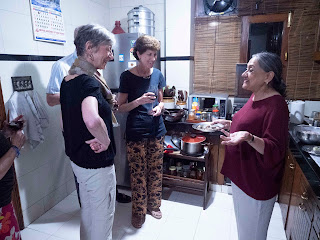Day 3: Delhi
Off this morning to our first destination, Qutb Minar.
The Qutb Minar, also spelled as Qutub Minar, is a minaret and "victory tower" that forms part of the Qutb complex, a UNESCO World Heritage Site in the Mehrauli area of Delhi, India.Qutb Minar was 73m (239.5 feet) tall before the final, fifth section was added after 1369. The tower tapers and has a 14.3m (47 feet) base diameter, reducing to 2.7m (9 feet) at the top of the peak. It contains a spiral staircase of 379 steps.
 |
| Early morning street shave |
 |
| Street kids performing for money |
We were western celebrities here with many of the visitors wanting photos with us.
Next “must see” was Humayun’s Tomb.
Built in 1564 by Mughal emperor Humayun's first wife, empress Haji Begum, in her husband's memory, the tomb houses the graves of both the emperor and his wife and stands as a testament to their eternal love. It was designed by Persian architect Mirak Mirza Ghiyas, and this garden tomb, first of its kind, was the inspiration for the Taj Mahal 70 years later. An interesting fact about the monument is that it also houses the tomb of Humayun's favorite barber and chef (had to be trusted- think razor and food poisoning). The monument was used by the last Mughal emperor Bahadur Shah Zafar as a refuge before the British captured and exiled him in 1857. To the right of the complex is the tomb of Isa Khan, a noble at the court of Sher Shah Suri.
It was also constructed in the 16th century. The Humayun's Tomb lies very close to another popular attraction of Delhi, Hazrat Nizamuddin Dargah, a shrine built over the grave of the 14th century Sufi Saint Nizamuddin Auliya.
From here, we drove to a neighborhood near the Delhi train station to meet two young guides, Ruhi and Samshad from Salaam Baalak Trust is an Indian non-profit and non-governmental organization designed to help street kids.
70-80 children arrive in Delhi (most at the train station) per day, running away from physical abuse, neglect, or just in search for a hope for a better life. Most between the ages of 5 and 18 wind up on the streets vulnerable to violence, sexual exploitation, and drug abuse. Salaam Baalak provides safe shelters, education, food and medical care for 10,000 of the 65,000 street kids in Delhi! The Trust has many success stories including our guides. Ruhi plans to be a flight attendant once she finishes school this year, and Samshad hopes to become a cricket coach.
 |
| Samshad and Ruhi |
 |
| Samshad |
 |
| Visiting the headquarters and a day care center |
 |
| Anne was a big hit, able to introduce herself in Hindi |
In stark contrast, we made a stop at a true Kashmir shop to look at $2500 payments. Some were quite beautiful (and expensive- the Rolls Royce of pashminas).
Some were actually within reach of mortals. Molly let Dave treat her to a Kashmir pashmina for those cold, winter Fort Lauderdale nights.
One last stop before a shower and dinner, the memorial to Mahatma Gandhi. This is the site of Gandhi’s assassination in 1947.
After a quick turnaround at the hotel, we were driven to a beautiful residential neighborhood for a cooking class and dinner at a private home. Our hostess was Parveen, a feminist activist turned self-taught cooking teacher.
She had a beautiful apartment with a lovely garden balcony,
and a pretty small kitchen for 10 of us, but the class was wonderful. The dinner was unlike most restaurant Indian food, flavorful, but not terribly spicy, and without heavy sauces. Carole summed it up,"They said last night's dinner was 5-star, but tonight's was truly the five-star meal!"
Early morning tomorrow for the train to Agra and the Taj Mahal.





























































No comments:
Post a Comment